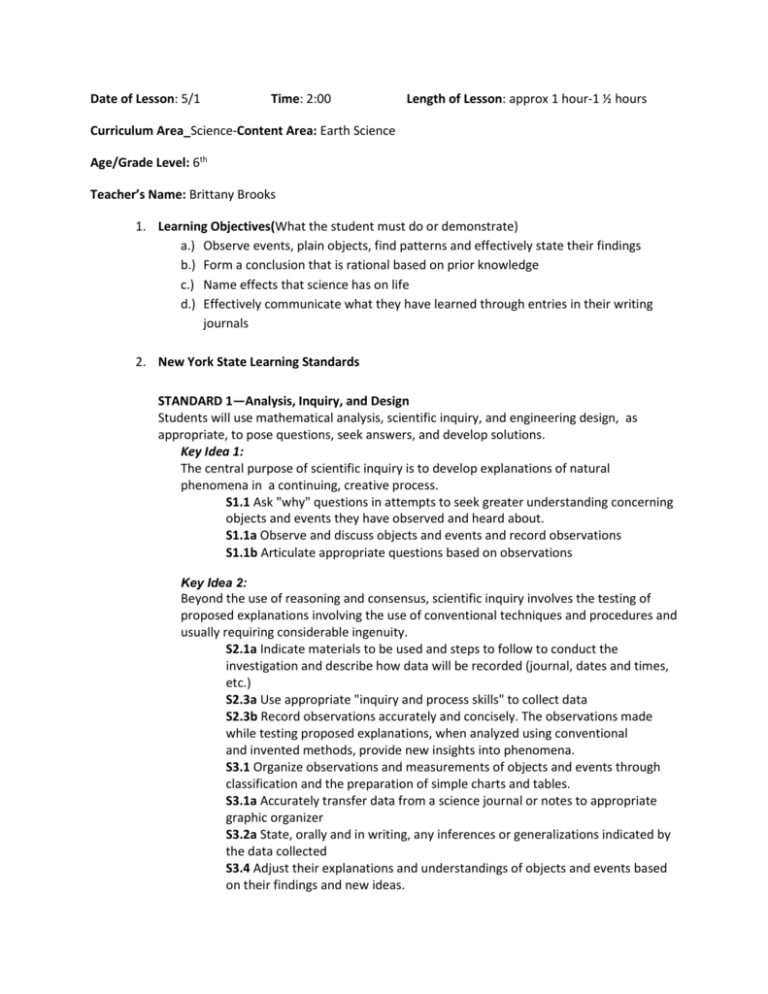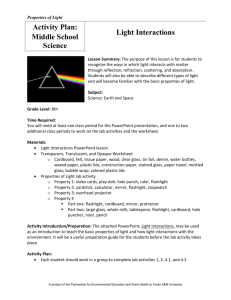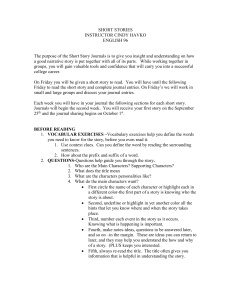Date of Lesson: 5/1 Time: 2:00 Length of Lesson: approx 1 hour
advertisement

Date of Lesson: 5/1 Time: 2:00 Length of Lesson: approx 1 hour-1 ½ hours Curriculum Area_Science-Content Area: Earth Science Age/Grade Level: 6th Teacher’s Name: Brittany Brooks 1. Learning Objectives(What the student must do or demonstrate) a.) Observe events, plain objects, find patterns and effectively state their findings b.) Form a conclusion that is rational based on prior knowledge c.) Name effects that science has on life d.) Effectively communicate what they have learned through entries in their writing journals 2. New York State Learning Standards STANDARD 1—Analysis, Inquiry, and Design Students will use mathematical analysis, scientific inquiry, and engineering design, as appropriate, to pose questions, seek answers, and develop solutions. Key Idea 1: The central purpose of scientific inquiry is to develop explanations of natural phenomena in a continuing, creative process. S1.1 Ask "why" questions in attempts to seek greater understanding concerning objects and events they have observed and heard about. S1.1a Observe and discuss objects and events and record observations S1.1b Articulate appropriate questions based on observations Key Idea 2: Beyond the use of reasoning and consensus, scientific inquiry involves the testing of proposed explanations involving the use of conventional techniques and procedures and usually requiring considerable ingenuity. S2.1a Indicate materials to be used and steps to follow to conduct the investigation and describe how data will be recorded (journal, dates and times, etc.) S2.3a Use appropriate "inquiry and process skills" to collect data S2.3b Record observations accurately and concisely. The observations made while testing proposed explanations, when analyzed using conventional and invented methods, provide new insights into phenomena. S3.1 Organize observations and measurements of objects and events through classification and the preparation of simple charts and tables. S3.1a Accurately transfer data from a science journal or notes to appropriate graphic organizer S3.2a State, orally and in writing, any inferences or generalizations indicated by the data collected S3.4 Adjust their explanations and understandings of objects and events based on their findings and new ideas. S3.4a State, orally and in writing, any inferences or generalizations indicated by the data, with appropriate modifications of their original prediction/explanation S3.4b State, orally and in writing, any new questions that arise from their investigation 3. Materials Hatchet by Gary Paulsen Science Journals Writing Utensil Clear, deep dish Water Milk (approx. 1 tablespoon) Flashlight Spoon 2 Clear drinking glasses Opaque bowl Penny 4. Lesson Process (A) Engage (10 minutes) Teacher will read an excerpt from Hatchet. This piece of the book discusses refraction and the bending of light. After reading this section, teacher will write the word refraction on the board and discuss what happened in the story and why fish were not able to be caught. A definition of refraction will be given to the students. Students will write the definition of refraction and what happened in the story with refraction in their science journals. (B) Explore (10minutes) 1. Teacher will demonstrate refraction to the entire class using the large clear deep dish, a flashlight, milk and water. 2. Teacher will: a) Begin by filling the dish with water b) Add a few drops of milk to the water (adding more if needed to give water a cloudy look) c) Shine flashlight into water (varying the angle of the light entering the water if need be) 3. Make sure students can see the light bend as it enter the water 4. Discussion of what happened when light entered the water 5. Students should be able to communicate the relationship between the occurrence and the definition that was given to them during the engage 6. Students will record the results in their science journals, paying specific attention to why the light bent. Links to other curriculum Areas: Math- (angles) Connections Strand Students will recognize and apply mathematics in contexts outside of mathematics. 6.CN.6 Recognize and provide examples of the presence of mathematics in their daily lives. ELA- (writing in their journals and HW assignment) NYS ELA Standard OneStudents will read, write, listen, and speak for information and understanding. As listeners and readers, students will collect data, facts, and ideas; discover relationships, concepts, and generalizations; and use knowledge generated from oral, written, and electronically produced texts. As speakers and writers, they will use oral and written language to acquire, interpret, apply, and transmit information. (reporting what they learned in their science journals.) (C) Explain (15 Minutes) Students will be grouped in pairs to discuss what was learned from this lesson and what they witnessed during the teacher’s demonstration to the class. I will use a think pair share after asking them “does light passing through water make a difference on how we see things or is it the opacity of the water that really matters?” Teacher will review what was learned by leading a class discussion of the activity and what occurred. Students will be told that refraction is just one of the many characteristics of light. Since light usually travels in straight lines, it bends as I passes from objects of different densities. Light travels at 186,000 miles per second. If a material is more dense than air the slower the speed of light will be. Light passes slower through water as an example. Also , give a brief overview of the learning centers and what the activities included will entail, also letting them know we will discover the question that was asked of them. Students will be able to tell teacher what happened in the activity with detailed descriptions. Also give an account of what they wrote that happened to Brian in the story hatchet. Teacher will make sure they know that Brian could not catch the fish because they were not where he thought they were because of the refraction. (D) Extend, Expand, Elaborate(15 Minutes) If time allows I would have students work on more activities that could actually be center activities if time does not allow. Bending rays o In this activity students will draw a vertical line on a sheet of paper, one that is about four or five inches long. o o Students will place this paper on the bottom of the glass, cutting it in half. Students will peer into the glass and keeping their head still they will poor water into the glass to see what happens to the line. Spoon in a glass o In this activity students will fill a clear glass with water. o Then they will place a spoon in the glass. o Looking into the glass from the side, students will notice what happened to the spoon after being placed in the water. (E) Evaluation (a.) Learning outcomes of previous lessons related to this topic. (b.) Focus of assessment in this lesson 1. Assess student’s ability to find patterns, observe events and plain objects, and effectively state their findings. 2. Evaluate student’s ability to form a reasonable conclusion based on prior knowledge and new information presented 3. Review student’s ability to name the effects that science has on life 4. Assess students ability to communicate what they have learned through entries in their science journals (c.) Method of assessment Students will write entries in their science journals about the day’s activity and what they learned from the lesson, activity and the learning centers they went through afterwards. (d.) Differentiation i. Low Level Students Students will demonstrate their knowledge gained from lesson and activity in whatever way they can best display and relay information. Expectation that students will be able to give an account of what happened in the story and how it was similar to what we saw in the classroom activities. (type of adaptation- output) ii. Higher Level Students These students would have their science journals handed in and graded. Teacher would pay attention to detail on their entries. (e) Lesson modifications i. Low Level Students These students may be paired with a confident student who would keep the group on task and help the lower level student understand what is going on in the activity. Also, students may want to have the opportunity to be provided with an online activity if they cannot focus on the activity that is going on in the classroom. ii. Higher Level Students These students could be given the challenge paper about the disappearing penny and answer questions about what happened to arcimedes ships once they have finished the other activities the class was working on. To make the activity more challenging, students could see if the angle that they look into the glass has an effect on what they see. They should explain in detail. 5. Assessment of lesson Assessment will be based on the journal entries. 6. Student work Challenge worksheet (attached. ) Homework- Writing their own story about light refraction, being sure to include new vocabulary and ideas they have learned through lesson and activities. 7. Learning Center There will be three stations in this learning center. (2 of these centers were used as extensions of there was time) Spoon in a Glass (explained above) Bending Rays(explained above) Magic Penny o Students will place a clear container on the table and place a penny in the bottom of the container (no water) o Students will start walking away from the container keeping their eye on the penny. o When the students can no longer see the penny, they stop. o Another student from the group will pour water in the container and they will watch the penny reappear. o A discussion of why this happened should occur as well as an entry into their science journals. 8. References Needham, F(Ed.). (2005). ScienceSaurus. Wilmington, MA: Houghton Mifflin Company. Pgs(314) Reed, Kirsten (2002, August 9th). Utah Education Network. Retrieved April 3rd, 2009, from www.uen.org/lessonplan/preview.cgi?LPid=2339







